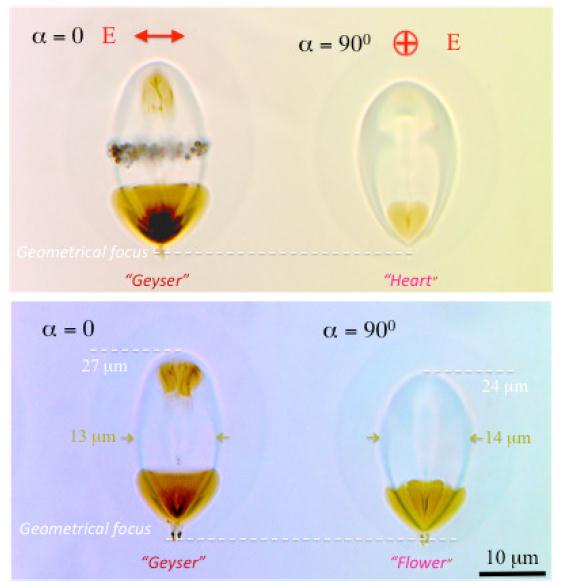Material processing with ultrafast lasers has recently attracted considerable interest due to a wide range of applications including laser surgery, optical data storage, integrated optics, 3D micro- and nano-structuring. However, despite significant efforts, the physics of interaction of intense ultrashort light pulses with transparent materials still is not fully understood.
Recently, two remarkable phenomena have been reported: nonreciprocal photosensitivity manifesting itself as dependence of material modification on light propagation direction in non-centrosymmetric crystal and a quill writing effect revealing strong dependence of the material modification in glass on the orientation of writing direction relative to the direction of the pulse-front tilt. In these effects, dependence of the imprinted structures on polarization of the laser beam can be attributed to the intrinsic anisotropy of the experiment associated with the beam movement. However, in stationary conditions, the optical anisotropy produced by an intense polarized pump beam can be revealed only using a second light beam of different polarization. In particular, photosensitivity of an isotropic medium is polarization independent .
In November this year, Researchers at University of Southampton , Kyoto University and Shanghai Institute of Optics and Fines Mechanics, Chinese Academy of Sciences (SIOM, CAS)observed that it is not necessarily true when isotropic medium interacts with intense femtosecond optical pulses possessing a tilted intensity front. They demonstrate that the modification of glass depends on the mutual orientation of the light polarization azimuth and the pulse front tilt (PFT).
During their work, researchers demonstrate for the first time that modification of the transparent isotropic glass by intense ultra-short laser pulse can depend on the polarization azimuth of the laser beam.[OPTICS EXPRESS. / Vol. 19, No. 21 / 2011: 20664]. They present the first experimental evidence of anisotropic photosensitivity of an isotropic homogeneous medium under uniform illumination. Their experiments reveal fundamentally new type of light induced anisotropy originated from the hidden asymmetry of pulsed light beam with a finite tilt of intensity front. We anticipate that the observed phenomenon, which enables employing mutual orientation of a light polarization plane and pulse front tilt to control interaction of matter with ultrashort light pulses, will open new opportunities in material processing.
Researchers attribute this new phenomenon to the anisotropy of the light-matter interaction caused by space-time couplings in ultra-short light pulses, which opens an interesting opportunity in the control of photon flux interacting with a target submerged into condensed isotropic medium.
 |
Fig. Optical microscope images of modified regions along beam propagation direction for writing beam polarised along (α = 0)
and perpendicular (α = 90°) to the pulse intensity front normal for exposure time 2 s (bottom) and 8 s (top).(Image by SIOM)